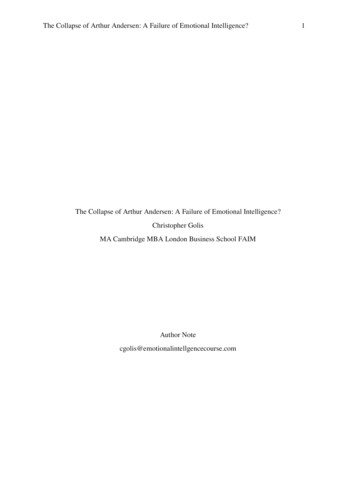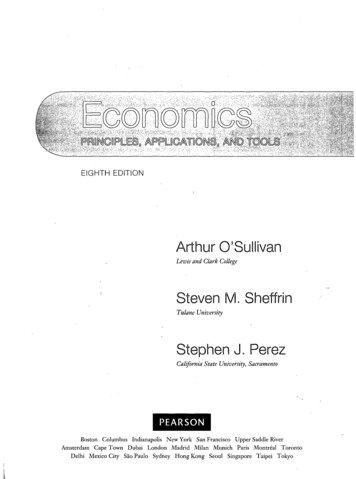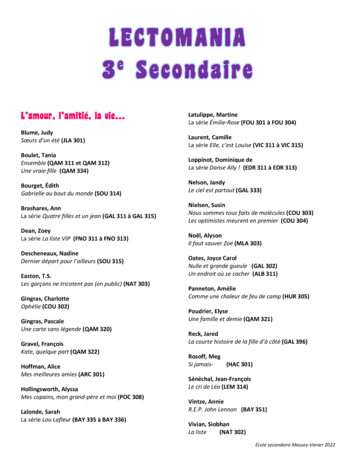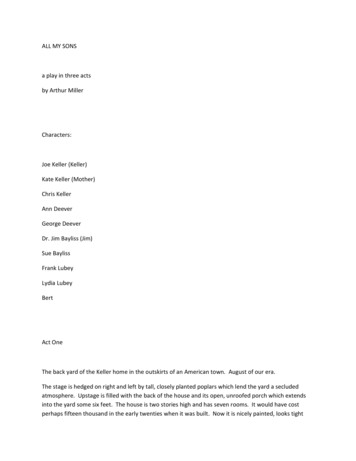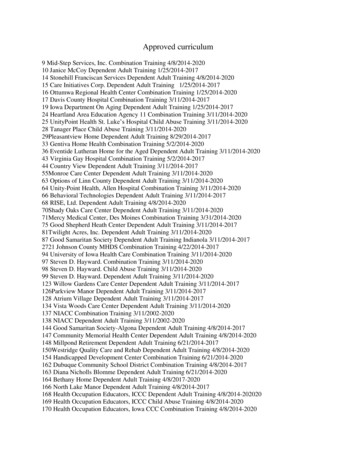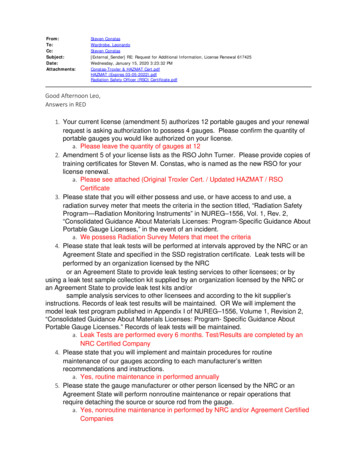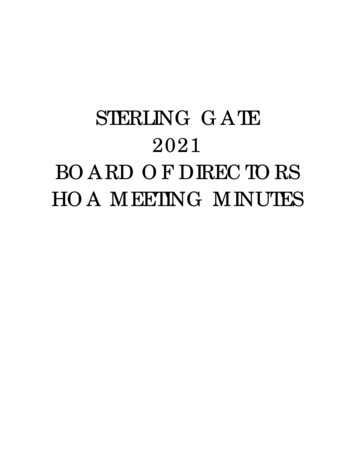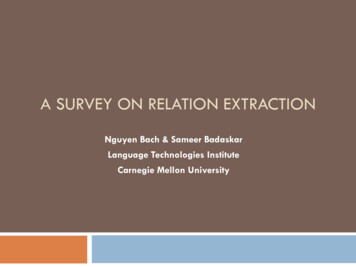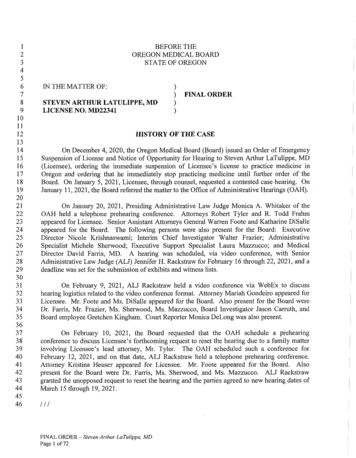
Transcription
031323334353637383940414243444546BEFORE THEOREGON MEDICAL BOARDSTATE OF OREGONIN THE MATTER OF:))STEVEN ARTHUR LATULIPPE, MDLICENSE NO. MD22341FINAL ORDER)HISTORY OF THE CASEOn December 4, 2020, the Oregon Medical Board (Board) issued an Order of EmergencySuspension of License and Notice of Opportunity for Hearing to Steven Arthur LaTulippe, MD(Licensee), ordering the immediate suspension of Licensee’s license to practice medicine inOregon and ordering that he immediately stop practicing medicine until further order of theBoard. On January 5, 2021, Licensee, through counsel, requested a contested case hearing. OnJanuary 11, 2021, the Board referred the matter to the Office of Administrative Hearings (OAH).On January 20, 2021, Presiding Administrative Law Judge Monica A. Whitaker of theOAFI held a telephone prehearing conference. Attorneys Robert Tyler and R. Todd Frahmappeared for Licensee. Senior Assistant Attorneys General Warren Foote and Katharine DiSalleappeared for the Board. The following persons were also present for the Board: ExecutiveDirector Nicole Krishnaswami; Interim Chief Investigator Walter Frazier; AdministrativeSpecialist Michele Sherwood; Executive Support Specialist Laura Mazzucco; and MedicalDirector David Farris, MD. A hearing was scheduled, via video conference, with SeniorAdministrative Law Judge (ALJ) Jennifer H. Rackstraw for February 16 through 22, 2021, and adeadline was set for the submission of exhibits and witness lists.On February 9, 2021, ALJ Rackstraw held a video conference via WebEx to discusshearing logistics related to the video conference format. Attorney Mariah Gondeiro appeared forLicensee. Mr. Foote and Ms. Di Salle appeared for the Board. Also present for the Board wereDr. Farris, Mr. Frazier, Ms. Sherwood, Ms. Mazzucco, Board Investigator Jason Carruth, andBoard employee Gretchen Kingham. Court Reporter Monica DeLong was also present.On February 10, 2021, the Board requested that the OAH schedule a prehearingconference to discuss Licensee’s forthcoming request to reset the hearing due to a family matterinvolving Licensee’s lead attorney, Mr. Tyler. The OAH scheduled such a conference forFebruary 12, 2021, and on that date, ALJ Rackstraw held a telephone prehearing conference.Attorney Kristina Heuser appeared for Licensee. Mr. Foote appeared for the Board. Alsopresent for the Board were Dr. Farris, Ms. Sherwood, and Ms. Mazzucco. ALJ Rackstrawgranted the unopposed request to reset the hearing and the parties agreed to new hearing dates ofMarch 15 through 19, 2021.///FINAL ORDER - Steven Arthur LaTulippe, MDPage 1 of72
031323334353637383940414243444546On February 22, 2021, the Board filed a Motion for Qualified Protective Order and aproposed “Qualified Protective Order Limiting Use and Disclosure.” On February 26, 2021,Licensee, through counsel, filed an Opposition to Motion for Protective Order and Cross-Motionfor Discovery. On March 2, 2021, the Board filed a Response to Opposition to Motion forQualified Protective Order and Response to Cross-Motion for Discovery. On March 12, 2021,ALJ Rackstraw issued a Ruling on Motion for Protective Order and Qualified Protective Order,as well as a Ruling Denying Cross-Motion for Discovery.On March 15, 16, 17, 18, 19, and 24, 2021, a hearing occurred via video conference, withALJ Rackstraw presiding. Ms. Heuser represented Licensee. Mr. Foote represented the Board.Court Reporter LeeAnne McAdam was present and subsequently provided a written transcript ofthe proceedings. Tammy Clark was present for certain portions of the hearing on Licensee’sbehalf. The following witnesses provided testimony: Licensee; Dr. Farris; Dr. Melissa Sutton;Dr. Dawn Nolt; Board Investigator Carruth; Kathryn Ellis-Kelemen; Marina Bednarowski;Robert Berry; Cameron Miles; Margaret Murphy; Teresa LaTulippe; Dr. Thomas Stern; andKristen Kelly. The evidentiary record closed on March 24, 2021 .*Between March 15 and 24, 2021, the Board provided Draft Transcripts for the six days ofproceedings. On March 26, 2021, the parties filed their written closing arguments. On April 6,2021, the Board provided Second Draft Transcripts, along with Errata Sheets that noted minorcorrections to the transcripts from March 15, 16, 18, and 19, 2021.12The Board adopts the History of the Case, Issues, Evidentiary Ruling, Findings of Factand Conclusions of Law and Order contained in the Proposed order in their entirety, except formodifications provided herein and identified via footnotes. The Board also makes minormodifications to reflect that it, and not the Administrative Law Judge, is issuing the order.On April 21, 2021, ALJ Rackstraw issued a Proposed Order, recommending the Boardfind that Licensee’s continued practice of medicine constitutes an immediate danger to the publicand a serious danger to the public health or safety. The Proposed Order also recommended thatthe Board confirm its December 4, 2020 Order of Emergency Suspension of Licensee’s medicalLicense.3On May 1, 2021, Licensee submitted written exceptions to the Proposed Order. TheBoard has reviewed and considered these exceptions to the extent they did not attempt tointroduce new evidence, and finds they are without merit.///1 Pursuant to OAR 137-003-0560(4), at the January 20, 2021 prehearing conference, the parties agreed toextend the deadline for issuance of the Proposed Order from 15 days to 20 business days, given theanticipated duration and potential complexity of the hearing. See OAR 13 7-003-05 60(3 )(b).2 The transcript citations herein refer to the Second Draft Transcripts (with the minor corrections), designated asfollows: Transcript I: March 15, 2021; Transcript II: March 16, 2021; Transcript III: March 17, 2021; TranscriptIV: March 18, 2021; Transcript V: March 19, 2021; and Transcript VI: March 24, 2021.3 We modify the Proposed Order’s History section to include this new information.FINAL ORDER - Steven Arthur LaTulippe, MDPage 2 of 72
031323334353637383940414243444546ISSUES1. Whether Licensee’s continued practice of medicine constitutes an immediate dangerto the public or a serious danger to the public health or safety. ORS 183.430(2); ORS677.205(3); and OAR 137-003-0560(1) and (7).42. Whether circumstances at the time of the issuance of this final order5 justifyconfirmation, alteration, or revocation of the Board’s December 4, 2020 Order of EmergencySuspension of License. OAR 137-003-0560(7) and OAR 137-003-0655.6EVIDENTIARY RULINGSLicensee’s Exhibits R1 through R115 were admitted into the record without objection.The Board offered Exhibits Al through A25. Exhibits Al, A4 through A13, A15 throughA19, A21, A22, and A24 were admitted into the record without objection. Exhibits A2, A3,A14, A20, A23, and A25 were admitted over Licensee’s various objections.Pleadings Pl through P25 were also made a part of the record.FINDINGS OF FACTLicensee’s Relevant Background1. After high school, Licensee enlisted in the U.S. Air Force. He thereafter obtained aBachelor of Science degree in Biology from Boise State University (Boise State). Whilepursuing his undergraduate degree, he was active in the Idaho Air National Guard. He alsoattended Boise Bible College and Cincinnati Bible Seminary. He subsequently entered a Ph.D.program in Microbiology at the University of Massachusetts at Amherst, where he had ateaching assistantship and taught general microbiology and pathogenic bacteriology. He left thePh.D. program (prior to obtaining the advanced degree) to begin an aviation career in the U.S.Air Force, where he became a commissioned officer. (Tr. Ill at 7-9; Tr. V at 82-83.)2. In 1997, Licensee received his Medical Degree from Loma Linda University Schoolof Medicine, where he co-taught medical microbiology. He completed an internship andresidency in the Family Medicine Program at Wheeling Hospital in Wheeling, West Virginia.He received extensive training in rural family medicine, as well as training in surgical obstetrics,dermatology, intensive care, psychiatry, and the performance of upper and lower endoscopies.(Tr. Ill at 9-10; Tr. V at 83; see Ex. Al at 1-2.)3. In April 2000, Licensee obtained his Oregon medical license and started a FamilyMedicine practice, South View Medical Arts (the clinic), in Dallas, Oregon. (Tr. I at 84, Tr. Ill4 We modify the administrative rules cited to reflect those that apply to a final order, rather than a proposed order.5 We modify this phrase to reflect the now-relevant date.6 See footnote 4,FINAL ORDER Steven Arthur LaTulippe, MDPage 3 of72
031323334353637383940414243444546at 11; see Exs. Al at 1, A2 at 4.) Shortly thereafter, he joined the Oregon National Guard, wherehe served as a Medical Review Officer, Chief of Pharmacy, and Chief of Medicine. (Tr. Ill at11.)4. Dallas is a small quasi-rural community located approximately 20 to 25 minutes fromSalem. The geographic area is underserved with regard to Psychiatry, Pain Medicine, andAddiction Medicine. For the past decade, Licensee has spent approximately 50 percent of histime practicing Pain Medicine and Addiction medicine. The remainder of his practice consists ofproviding full-spectrum care to all ages, from newborn to geriatric patients. (Tr. I at 42, 84; Tr.Ill at 12-14.) He is approved as a supervising physician, and he has trained multiple physicianassistants at the clinic. (Tr. I at 47; Tr. Ill at 17; see Exs. Al at 5, A2 at 4.)5. Licensee is board certified in Family Medicine. (Tr. Ill at 11-12; Ex. Al at 1-2.) Hehas lectured on the topics of Pain Medicine and Addiction Medicine in Southern Oregon andOregon’s Willamette Valley, and he has published an article regarding central pain.7 (Tr. Ill at11.) He previously held clinical privileges at Salem Hospital and the North Bend SurgeryCenter, where he performed minor surgeries and endoscopies. (Tr. I at 43, 48; Tr. 3 at 14; Tr. Vat 83-85; see also Ex. Al at 6-8.)6. Excluding complaints related to the current matter, the Board has received 11complaints regarding Licensee. All but two of those 11 complaints closed without any Boardaction. One complaint closed in 2009, after the Board issued a Letter of Concern to Licenseeregarding his treatment of a 17-year-old patient who he had diagnosed with bi-polar disorder.One complaint, pertaining to an allegation of failing to adhere to prescribing guidelines, is still inthe investigatory process. (See Exs. Al at 3, A2 at 4.)COVID-19 Pandemic7. SARS-CoV-2 is a coronavirus that causes COVID-19, an infectious disease.8 (Tr. I at120, 122.)8. On February 28, 2020, the Oregon Health Authority (OHA) confirmed Oregon’s firstpresumptive case of COVID-19. (Ex. Al6 at 1; Tr. I at 147.) On March 8, 2020, OregonGovernor Kate Brown declared a state of emergency pursuant to ORS 401.165. (See ElkhornBaptist Church v. Brown, 366 Or 506, 512 (2020) (discussing Governor Brown’s issuance ofExecutive Order No. 2020-03 on March 8, 2020).) On March 11, 2020, the World HealthOrganization (WHO) declared the COVID-19 outbreak a global pandemic. (Tr. I at 122.)9. The Centers for Disease Control and Prevention (CDC) estimates that 4.9 percent ofall COVID-19 infections have resulted in hospitalization. Between March 1 and May 2, 2020,7 During his hearing testimony, Dr. LaTulippe did not specify the name of the article or the publication in which itappeared, and the remainder of the record is silent on those facts.8 At hearing, the terms “COVID-19” and “COVID” were sometimes used by hearing participants (myself included)as a catch-all for the SARS-CoV-2 virus and the COVID-19 disease or pandemic. Unless expressly stated herein,we make no relevant distinction between the uses of those terms in the record.FINAL ORDER - Steven Arthur LaTulippe, MDPage 4 of 72
03132333435363738394041424344454617 percent of all patients hospitalized for COVID-19 died. That figure has improved over time,but in-hospital mortality for COVID-19 remains higher than for influenza. (Tr. I at 159.)10. On May 9, 2020, the OHA issued an update to its “Clinical Care, and HealthcarePrevention and Control Guidance for COVID-19” recommending universal source control (z.e.,masking) for both patients and providers in all healthcare settings and advising that healthcareproviders wear a face covering or face mask at all times while in a healthcare facility, unlessalone in a private office.9 (Tr. I at 115-116, 186, 190-191.)11. Effective June 5, 2020, Governor Brown issued Executive Order No. 20-27, whichstates, in part:2. [P]ursuant to ORS 401.168(1), ORS 401.175(3), ORS 401.188(2) to (3),and ORS 433.441(3):b. Individuals must comply with any public health directives set forth inmy Executive Orders.c. Individuals should maintain physical distancing of at least six feet fromany person who is not a member of their household, when possible, andshould adhere to any applicable Oregon Health Authority (OHA)guidance, including but not limited to guidance on physical distancing ovstatus.egov.com/OR-OHA-COVID-19 .9. Guidance. At my direction, and under the authority of this and otherExecutive Orders, OHA and other appropriate agencies have issued andwill continue to issue and revise detailed guidance for the public, foremployers, and for particular sectors of the economy[.]25. Legal Effect. This Executive Order is issued under the authorityconferred to the Governor by ORS 401.165 to 401.236. Pursuant to ORS401.192(1), the directives set forth in this Executive Order shall have thefull force and effect of law, and any existing laws, ordinances, rules andorders shall be inoperative to the extent they are inconsistent with thisexercise of the Governor’s emergency powers.9 The OHA created the first version of its "Clinical Care, and Healthcare Prevention and Control Guidance forCOVID-19" in March 2020, (Tr. I at 186.)FINAL ORDER - Steven Arthur LaTulippe, MDPage 5 of 72
03132333435363738394041424344454626. Enforcement. The directives in this Executive Order and any guidanceissued by OHA or other state agencies to implement this Executive Orderare effective statewide, unless otherwise specified. This Executive Orderand any guidance issued by OHA to implement this Executive Order arepublic health laws, as defined in ORS 43IA.005, and may be enforced aspermitted under ORS 431A.010. In addition to any other penalty that maybe imposed under applicable laws, any person, business, or entity found tobe in violation of this Executive Order or any guidance issued by OHA orother state agencies to implement this Executive Order is subject to thepenalties described in ORS 401.990.(Oregon Executive Order No. 2O-27.)1012. On June 9, 2020, the CDC issued updated guidance for healthcare facilities, titled"Healthcare Facilities: Managing Operations During the COVID-19 Pandemic” (June 9, 2020Guidance). (See Ex. A10 at 1-5.) The CDC noted in the June 9, 2020 Guidance that previousguidance “was preventative and meant to help healthcare facilities prepare for communitytransmission, while current guidance is for managing operations during the pandemic.” (Id. at)1.The June 9, 2020 Guidance recommended that healthcare systems adjust their standarddelivery approaches to reduce the need for in-person care by optimizing the use of telehealth andmanaging mildly ill patients at home. (Id. at 2-3.) To prevent the transmission of COVID-19 byCOVID-19 infected persons who may or may not be showing symptoms, the June 9, 2020Guidance recommended that healthcare facilities use source control for all persons (e.g. staff,patients, and visitors) who enter a healthcare facility. The June 9, 2020 Guidance specified thatcloth masks are considered source control (and not personal protective equipment (PPE)), andwhile cloth masks may be appropriate for patients and visitors, healthcare personnel should wearPPE. (Id. at 3.)13. On July 22, 2020, after receiving citizen complaints alleging that some providerswere not masking in healthcare settings,1’ the OHA issued a stand-alone document making clearthat all healthcare personnel were required to wear masks at all times in all healthcare settings,unless they were alone in a private office. (Tr. I at 116-118, 182-184.) Also on July 22, 2020,the OHA updated its “Statewide Mask, Face Covering, Face Shield Guidance for Health CareOffices” (July 22, 2020 OHA Guidance). The July 22, 2020 OHA Guidance states, in pertinentpart:Authority: Executive Order No. 20-27, paragraphs 9 and 21, ORS433.441, ORS 433.443, ORS 431A.010Applicability: This guidance applies statewide to:10 Pursuant to ORS 183.450(4) and OAR 137-003-0615(1), the ALJ takes notice of this executive order, availableonline at https.7/www.oregon.gov/gov/Documents/executive orders/eo 20-27.pdf . Any party objecting to suchnotice was authorized to file an objection with the ALJ no later than three days after the issuance of the ProposedOrder. No party filed an objection.!l At hearing, Dr. Sutton estimated that the OHA had received between 10 and 20 such complaints throughoutOregon. (Tr. I at 118-119.) She opined that, despite those complaints, by July 2020, “almost all healthcareproviders were masking at all times in all healthcare settings” in Oregon. (See id.)FINAL ORDER - Steven Arthur LaTulippe, MDPage 6 of 72
31323334353637383940414243444546All health care personnel in health care offices, as defined below.All patients and visitors in health care offices, as defined below.Enforcement: To the extent this guidance requires compliance withcertain provisions, it is enforceable as specified in Executive Order 20-27,paragraph 26.For purposes of this guidance the following definitions apply: “Face covering” means a cloth, polypropylene, paper or other facecovering that covers the nose and the mouth and that rests snugly abovethe nose, below the mouth, and on the sides of the face. “Face mask” means a medical grade mask. “Face shield” means a clear plastic shield that covers the forehead,extends below the chin, and wraps around the sides of the face. “Healthcare Personnel (HCP)” means all paid and unpaid personsserving in healthcare offices who have the potential for direct or indirectexposure to patients or infectious materials * * *. HCP include, but are notlimited to, nurses, nursing assistants, physicians, * * *, and persons notdirectly involved in patient care, but who could be exposed to infectiousagents that can be transmitted in the healthcare setting (e.g., clerical * * *). “Health care office” means * * * [a]ny non-licensed medical, dental, orother health care office where health care is provided to patients, includingbut not limited to primary care offices, specialty care offices, * * *, andurgent care settings. “Physical Distancing” means maintaining a space of 6 feet or more in alldirections between individuals.Health care offices are required to: Have policies and enforce policies that require all individuals who enterthe health care office to wear a face mask, face covering or face shieldFINAL ORDER - Steven Arthur LaTulippe, MDPage 7 of 72
031323334353637383940414243444546while inside, including when in a private examination room, except asfollows: If a patient cannot tolerate any form of face mask, facecovering or face shield due to a medical condition, strict physicaldistancing must be observed until the patient can be placed orroomed in an area that minimizes risk to others. A face mask, face covering or face shield is not required to beworn during an examination or procedure in which access toparts of the face that are covered by a face mask, face coveringor face shield is necessary. A face mask, face covering or faceshield is required to be worn as soon as the examination orprocedure in question has completed. Have policies and enforce policies that require HCP to wear* appropriatepersonal protective equipment (PPE) for the care of patients withsuspected COVID-19, confirmed COVID-19, or a known exposure toCOVID-19 (See “PPE for Healthcare Personnel” Section).Health care personnel are required to: Wear a face mask or face covering that covers the nose and mouth at alltimes while in the health care office, except when in a private office bythemselves. Face masks should be prioritized over face coverings becausethey offer both source control and protection for the HCP frompotentially infectious droplets, splashes, or sprays. Cloth face coverings may not be worn instead of a respirator orface mask if more than source control is needed.Face shields should be worn in addition to, but not in place of,face masks for the purposes of eye protection and additionallayer of splash protection.aa Face masks or face coverings are not required while eating ordrinking, but strict physical distancing should be maintainedwhile face masks, face shields, or face covering are not worn.FINAL ORDER - Steven Arthur LaTulippe, MDPage 8 of72
31323334353637383940414243444546 Wear N95 masks or higher-level respiratory protection instead of a facecovering or face masks for patient care that warrants a higher level ofprotection (See “PPE for Healthcare Personnel” Section).AH patients and visitors when visiting a health care office are requiredto: Wear a face mask, face covering, or face shield unless the individual isunder five (5) years of age, except as follows: Face masks, face shields or face coverings are not requiredwhile eating or drinking, but strict physical distancing (6 feet ormore) should be maintained while face masks, face shields, orface covering are not worn. A face mask, face covering or face shield is not required to beworn during an examination or procedure where access to partsof the face that are covered by a face mask, face covering or faceshield is necessary. A face mask, face covering or face shield isrequired to be worn as soon as the examination or procedure inquestion has completed. Face masks, face shields or face coverings can be brieflyremoved in situations where identity needs to be confirmed byvisual comparison. If possible, limit speaking while the cover isoff as speaking generates aerosols and droplets that can containviruses.Use of a face shield alone should be limited to situations whenwearing a face mask or face covering is not feasible in thefollowing situations: When a person has a medical condition that prevents themfrom wearing a face mask or face covering. When people need to see mouth and tongue motions in orderto communicate (e.g., teachers of children in certaindevelopmental stages or when communicating with people withhearing impairments).Notify a health care office or their HCP in advance of an office visit if theindividual has a medical condition that makes it hard to breathe or aFINAL ORDER - Steven Arthur LaTulippe, MDPage 9 of72
031323334353637383940414243444546disability that prevents them from wearing a face mask, face shield or facecovering, so that appropriate accommodations can be made that ensure thesafety of other patients and visitors, and HCPs.(Ex. A23 at 1-4; bold emphasis in original.)Licensee’s Clinic Practices14. For at least the last two years, Emily Miles worked as the clinic’s receptionist, andMrs. LaTulippe, Licensee’s wife, worked as Licensee’s medical assistant and office manager.(Tr. I at 47-48; Tr. II at 236; Tr. Ill at 16-17.) Ms. Miles had no formal medical training.12 (Tr.V at 127.)15. Prior to the COVID-19 pandemic, the clinic maintained a seasonal cold and fluprotocol that included heightened sanitation standards. (Tr. I at 53; Tr. Ill at 41; Tr. V at 52.)The clinic also had an air ventilation system that filtered and recirculated air at least every hour.(Tr. V at 123-124.) After COVID-19 was declared a pandemic, Licensee added the following tohis typical cold and flu season clinic protocols: social distancing of patients in the waiting room(/. e., six-foot rule); taking patients to examination rooms quickly; trafficking patients through theclinic in designated directions so they would not cross paths with one another; placing handsanitizer at the receptionist window and in the common area behind the receptionist forpatient/visitor use;13 scheduling patients with complaints of cough, congestion, fever, anosmia,and/or other symptoms suggestive of viral illness either at the end of the workday or during thelunch hour when no other patients were present at the clinic; taking such patients immediately toan examination room; and increasing the clinic’s already heightened cold and flu seasonsanitation procedures. (Tr. I at 53-54, 60-62; Tr. Ill at 45-48, 91; Tr. V at 37-38, 51-52, 122,125, 128.)16. The clinic’s written “Coronavirus Protocol” states:1. Direct to ED—all patients with severe presumptive COVID symptoms:fever, chough [sic], muscle aches, chest tightness/pain, shortness of breath.2. Keep distance of 6 feet between all patients.3. Minimize contact between and with patients.4. One-way entry and exit for all patients.5. Only one patient per room.6. Don a mask on any patient with a cough, fever, or any suspicious viralillness.12 The record is silent as to whether Mrs. LaTulippe has any formal medical training.!3 At hearing, Licensee clarified that the sanitizer was present and made available to patients year-round, but that heand clinic staff actively encouraged patients to use it during cold and flu season. (See Tr. Ill at 46-47.)FINAL ORDER - Steven Arthur LaTulippe, MDPage 10 of 72
0313233343536373839404142434445467. Thoroughly sanitize exam room after each patient leaves room.8. Those who refuse to come in, schedule back in 2 weeks.9. Provide refills to next follow-up visit.10. Patients and staff wash hands before and after each patient contact.(Ex. A5 at 10.)17. Clinic staff conducted an initial screening of patients for COVID-19 illness when apatient first called the clinic to make an appointment. Mrs. LaTulippe would conduct a“telephone triage"’ and ask questions about the patient’s symptomology and course of illness.(See Tr. V at 45.) The clinic’s COVID-19 screening protocol did not include calling patientsprior to their regularly scheduled appointments to screen for potential COVID-19 symptoms.Licensee instead relied upon “common sense” and expected that if a patient with a regularlyscheduled appointment was “significantly sick,” the patient would call prior to their appointmentto report such illness. (Id. at 46.) Licensee’s COVID-19 screening protocols did not includetaking temperatures on all patients who presented at the clinic. (Tr. I at 60; Tr. Ill at 43-44.)Licensee’s COVID-19 screening protocols did not include asking patients if they had been inclose contact with any person who had COVID-19 symptoms or who had tested positive forCOVID-19. (Tr. Vat47-49.)18. As of approximately March 2020, when a patient arrived at the clinic for a routinescheduled appointment, Licensee relied upon Ms. Miles to assess whether the patient hadsymptoms suggestive of COVID-19. (Tr. V at 46-47.) Licensee had trained Ms. Miles “to lookat [the patient] and just take a look at them and see if they look sick,” and, if the patient was“smiling and happy,” Ms. Miles was instructed to ask how the patient was feeling. (Id. at 46-47.)If the patient indicated that they “felt fine” and they were “not ill,” Ms. Miles would direct thepatient to sit in the waiting area (maintaining social distance) until Mrs. LaTulippe led them to anexamination room. (Tr. I at 60.) If Ms. Miles made a visual determination that a patient lookedsick, or the patient indicated that they had symptoms of COVID-19 or they were not feeling well,the patient was immediately taken to a designated examination room. (Tr. V at 47.)19. When performing invasive surgical procedures on patients, whether at the clinic (orhistorically at a surgical center), consistent with standard protocol for surgical suites, Licenseewore a surgical mask. (Tr. I at 43-44, 75-76.) However, in Licensee’s opinion, “there is nomedical evidence that proves that masks are even of benefit during surgery.” (Id. at 45.)20. Absent surgical procedures, Licensee did not wear a mask when treating patients atthe clinic between March 2020 and December 2020. Licensee did not require patients or clinicvisitors to wear masks during that time period, unless they were “acutely ill, coughing, [or]HlFINAL ORDER - Steven Arthur LaTulippe, MDPage 11 of72
031323334353637383940414243444546congested,” or otherwise had signs suggestive of respiratory illness.14 (Tr. I at 50-52, 54, 60-61;Tr. V at 19-20.) Licensee estimates that at least 95 percent of his patients chose not to wear amask while at his clinic. (Tr. IV at 90.) Licensee has never demanded that a patient removetheir mask at the clinic. (Tr. I at 55.) Mrs. LaTulippe and Ms. Miles did not wear masks at theclinic between March 2020 and December 2020.15 (See Tr. V at 19, 160.)21. Licensee acknowledges that a person does not have to be coughing to passrespiratory droplets infected with SARS-CoV-2 to other persons, and he acknowledges thatmasks can capture large respiratory droplets. However, he believes that masks do not capturesmall respiratory droplets and aerosols, and that respiratory aerosols account for approximately80 percent of SARS-CoV-2 transmission.16 (Tr. V at 95.) Because Licensee believes maskingdoes not protect a wearer from aerosols, when treating a COVID-19 infected patient at the clinicin 2020, Licensee never wore a mask. But be
Specialist Michele Sherwood; Executive Support Specialist Laura Mazzucco; and Medical Director David Farris, MD. A hearing was scheduled, via video conference, with Senior Administrative Law Judge (ALJ) Jennifer H. Rackstraw for February 16 through 22, 2021, and a deadline was set for the submission of exhibits and witness lists.
